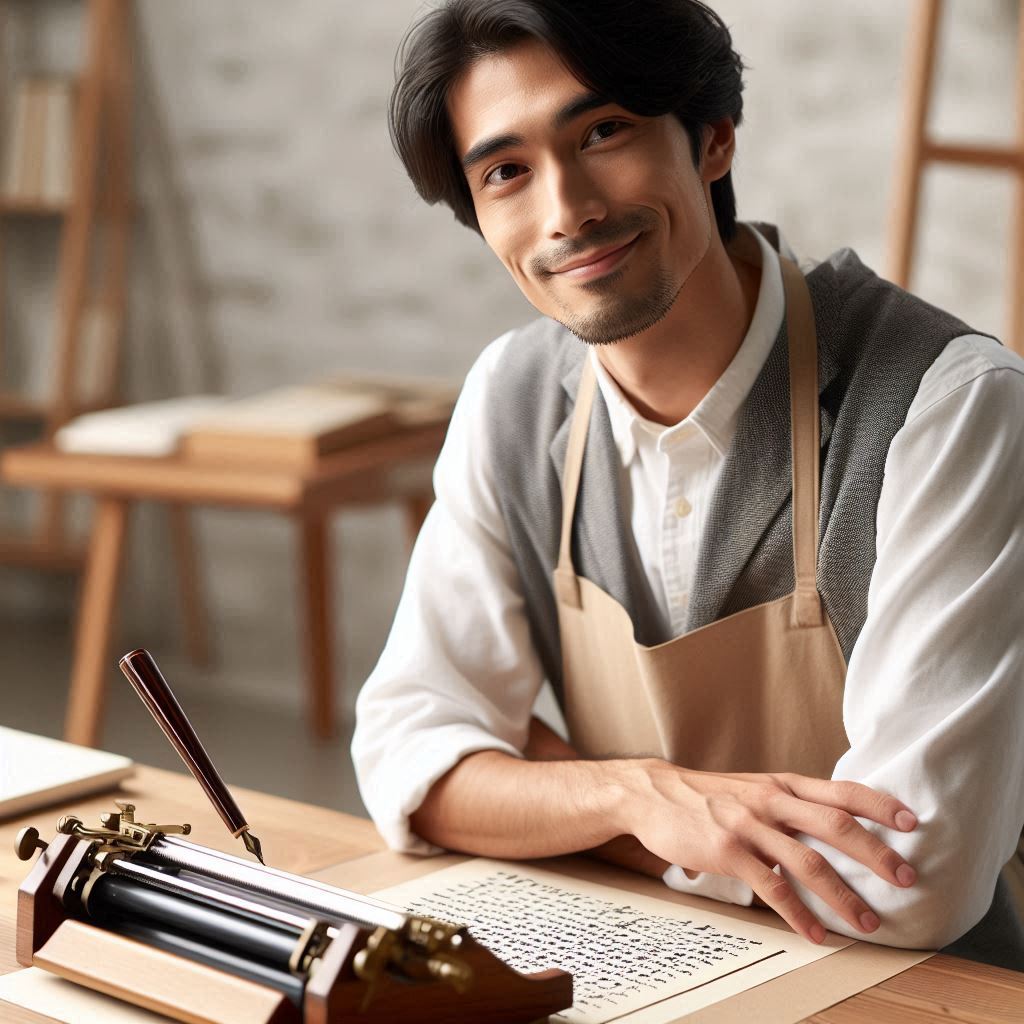Introduction
In today’s digital age, calligraphy continues to evolve as a traditional art form that has found new relevance and popularity.
The beauty of calligraphy lies in its ability to transform ordinary words into visually stunning works of art.
The Influence of Digital Tools in Modern Calligraphy
Digital tools have revolutionized the world of calligraphy by providing artists with new ways to create, experiment, and share their work.
These tools range from software programs and digital brushes to tablets and styluses, enabling calligraphers to explore a wide range of artistic possibilities.
Enhanced Creativity
Digital tools offer calligraphers a plethora of options to experiment with different styles, colors, and textures.
Artists can easily create intricate designs, mix various fonts, and add special effects to their work, pushing the boundaries of traditional calligraphy.
Efficiency and Productivity
With digital tools, calligraphers can streamline their workflow, saving time and effort.
Editing mistakes, adjusting layouts, and duplicating elements become easier tasks, allowing artists to focus more on their creative process rather than technical limitations.
Accessibility and Sharing
Digital platforms enable calligraphers to showcase their work to a wider audience online.
Social media, websites, and online communities provide a platform for artists to connect, collaborate, and seek inspiration from fellow calligraphers around the world.
In essence, digital tools have transformed the landscape of calligraphy, offering artists new possibilities for creativity, efficiency, and connectivity.
Embracing these tools allows calligraphers to continue pushing the boundaries of this ancient art form while staying relevant in the modern era.
Evolution of Calligraphy
Traditional methods of calligraphy using pen and paper
Calligraphy has deep historical roots, originating in ancient civilizations.
Traditionally, artists used pen and paper to create intricate designs.
They employed various tools, such as quills, brushes, and inks, to achieve unique styles.
Each stroke required precision and practice, resulting in beautifully crafted letters.
However, the advent of digital technology transformed this ancient art form.
Artists began exploring digital tools like graphic tablets and design software.
These innovations allowed for greater flexibility and creativity.
Digital calligraphy eliminates the need for physical supplies, making it more accessible to many.
Transform Your Career Today
Unlock a personalized career strategy that drives real results. Get tailored advice and a roadmap designed just for you.
Start NowWith just a stylus and a screen, artists can produce stunning work without the mess of ink.
The shift towards digital tools and how they have transformed the art form
The shift towards digital tools has also expanded artistic possibilities.
Artists can easily experiment with colors, styles, and designs.
They can undo mistakes with a simple click, reducing the pressure to get every stroke perfect.
Digital calligraphy opens doors to endless experimentation and personalization.
Benefits of using digital tools in calligraphy
Using digital tools offers numerous benefits.
Artists can save their work in various formats, making it easy to share and print.
The ability to create multiple versions of a design enhances creativity and exploration.
Digital platforms also facilitate collaboration, allowing artists to connect and share techniques globally.
In summary, the evolution of calligraphy reflects a significant shift from traditional methods to digital tools.
While the essence of the art remains, technology has expanded its boundaries.
Digital tools empower artists to express themselves in new and innovative ways, enriching the world of calligraphy.
Read: Freelance Tips for Calligraphy and Design Experts
Types of Digital Tools
In the world of modern calligraphy, digital tools have become essential for artists looking to enhance their creativity and efficiency.
Here are some of the most commonly used digital tools:
Tablets
Tablets, such as iPads or Android tablets, have revolutionized the way calligraphers work.
With their high-resolution screens and stylus compatibility, they provide a digital canvas for artists to practice their craft.
Tablets allow calligraphers to work on-the-go, eliminating the need for bulky paper pads and ink bottles.
They also offer a range of digital brushes and pens that mimic traditional calligraphy tools.
Popular tablets among calligraphers include the Apple iPad Pro and the Samsung Galaxy Tab S7.
Transform Your Career Today
Unlock a personalized career strategy that drives real results. Get tailored advice and a roadmap designed just for you.
Start NowThese devices offer advanced features like pressure sensitivity and palm rejection, making them ideal for intricate calligraphy work.
Stylus Pens
Stylus pens are another crucial tool for digital calligraphy.
These pens are designed to simulate the feel of traditional calligraphy pens, providing artists with precision and control over their strokes.
Stylus pens come in various tip sizes and shapes, allowing calligraphers to experiment with different styles and techniques.
They also offer features like pressure sensitivity, which can create varying line thicknesses based on the artist’s touch.
Popular stylus pens in the market include the Apple Pencil and the Wacom Bamboo Ink.
These pens are highly responsive and accurate, making them a favorite among calligraphers who value precision and detail in their work.
Design Software
Design software, such as Adobe Illustrator and Procreate, play a vital role in modern calligraphy.
These programs offer a wide range of tools and features that help artists create intricate and visually appealing lettering.
Design software allows calligraphers to manipulate their strokes, adjust colors, and add special effects to their work.
They also offer advanced text editing options, making it easier for artists to experiment with different fonts and styles.
Calligraphers often use design software to digitize their hand-lettered pieces, enabling them to easily share their work online or print it on various mediums.
These programs enhance the creative process and give artists more flexibility in their designs.
Overall, digital tools have revolutionized the world of calligraphy, allowing artists to push the boundaries of traditional lettering and explore new techniques.
Whether using a tablet, stylus pen, or design software, these tools provide endless possibilities for creativity and innovation in modern calligraphy.
Read: How to Market Your Art and Design Services
Accessibility and Affordability
When it comes to calligraphy, digital tools have played a significant role in making this art form more accessible to a wider audience.
Here are some key points to consider:
Increased Accessibility
With the rise of digital tools, calligraphy is no longer limited to those who can afford expensive traditional supplies.
People from all walks of life can now access various digital tools to practice calligraphy, leading to a more diverse community of artists.
Transform Your Career Today
Unlock a personalized career strategy that drives real results. Get tailored advice and a roadmap designed just for you.
Start NowOnline platforms and apps offer a user-friendly interface, making it easier for beginners to get started with calligraphy.
Cost-Effectiveness
Using digital tools for calligraphy is often more cost-effective than purchasing traditional supplies like parchment, ink, and nibs.
Many digital calligraphy tools offer a one-time purchase or subscription model, which can be more affordable in the long run.
Digital tools also eliminate the need for frequent replacements, as they do not wear out like traditional supplies.
Convenience of Learning
Learning calligraphy through online tutorials and resources has never been easier, thanks to digital tools.
Online platforms provide step-by-step guides, video tutorials, and interactive lessons to help beginners master various calligraphy styles.
Students can learn at their own pace, pause and replay tutorials, and seek inspiration from a global community of calligraphers online.
In fact, the accessibility and affordability of digital tools in modern calligraphy have democratized this art form, allowing more individuals to explore their creativity and express themselves through beautiful lettering.
Read: Building a Portfolio for Aspiring Tattoo Artists

Customization and Versatility
The endless possibilities for customization and personalization with digital tools
When it comes to modern calligraphy, one of the key advantages of using digital tools is the level of customization and versatility they offer.
Calligraphers can explore a vast array of options to personalize their work and experiment with different styles, colors, and effects that would be difficult to achieve with traditional tools.
How calligraphers can experiment with different styles, colors, and effects digitally
Digital tools provide an opportunity for artists to push the boundaries of traditional calligraphy and create unique pieces that truly reflect their individual style.
Whether it’s through the use of digital brushes, textures, or effects, artists can easily enhance their work and bring their creative vision to life.
How digital tools allow for easy corrections and edits to the artwork
One of the significant benefits of digital tools is the ease with which calligraphers can make corrections and edits to their artwork.
Unlike traditional mediums where mistakes are harder to fix, digital tools allow artists to undo, erase, and adjust their work with just a few clicks.
This flexibility not only saves time but also encourages artists to experiment and refine their craft without the fear of making irreversible errors.
Furthermore, digital tools enable calligraphers to save multiple versions of their work, compare different iterations, and choose the best one that resonates with their vision.
This ability to iterate quickly and make changes on the go empowers artists to hone their skills and produce high-quality work efficiently.
In short, customization and versatility are essential aspects of modern calligraphy, and digital tools play a crucial role in enhancing these qualities.
By leveraging digital tools, calligraphers can unleash their creativity, experiment with new styles, and produce artwork that is truly unique and impactful.
Transform Your Career Today
Unlock a personalized career strategy that drives real results. Get tailored advice and a roadmap designed just for you.
Start NowRead: Top 5 Design Schools for Aspiring Artists
Collaboration and Sharing
Role of digital tools in fostering collaboration among artists and calligraphers
Digital tools play a crucial role in fostering collaboration among artists and calligraphers.
With platforms like Procreate and Adobe Creative Cloud, artists can work together remotely.
Collaborating on pieces in real-time is made easier with tools that allow for shared canvases.
Artists can give feedback, make suggestions, and improve each other’s work effortlessly.
The ease of sharing work online through social media platforms and websites
The ease of sharing work online through social media platforms and websites is unparalleled.
Artists can instantly showcase their creations to a global audience with just a few clicks.
Social media platforms like Instagram and Pinterest provide a free and accessible space for artists.
Sharing work on these platforms allows artists to reach a wider audience than ever before.
Artists can collaborate and share their work with people from different parts of the world.
Benefits of receiving feedback and exposure from a wider community
The benefits of receiving feedback and exposure from a wider community are immense.
Constructive criticism from fellow artists can help improve one’s skills and techniques.
Exposure to a wider audience can lead to more opportunities, commissions, and recognition.
Building a community of like-minded individuals through digital tools fosters growth and creativity.
The support and encouragement received from fellow artists can boost confidence and inspiration.
By sharing their work online, artists can inspire and motivate others in the community.
In general, digital tools have revolutionized the world of calligraphy and art.
From creating intricate designs to collaborating with artists worldwide, digital tools offer endless possibilities.
The ease of sharing work online and receiving feedback has transformed the way artists interact and grow.
Embracing digital tools in calligraphy not only enhances creativity but also expands artistic horizons.
Transform Your Career Today
Unlock a personalized career strategy that drives real results. Get tailored advice and a roadmap designed just for you.
Start NowAs technology continues to evolve, the role of digital tools in modern calligraphy will only grow stronger.
Artists and calligraphers who leverage these tools will find new ways to express themselves and connect with a global community.
The future of calligraphy is digital, and those who embrace this shift will continue to push the boundaries of creativity.
Preservation and Storage
The issue of preserving traditional calligraphy work
Traditional calligraphy work is a precious art form that needs proper preservation.
Digital tools play a significant role in storing and organizing digital copies of calligraphy artwork.
One key advantage of digital tools is the ease with which artwork can be saved and accessed.
With the help of scanners and digital software, calligraphers can create high-quality digital versions.
Preserving the original physical copy is essential, but having a digital backup adds an extra layer of security.
Importance of Backup and Cloud Storage
Having backups of calligraphy work is crucial to protect against loss due to accidents or data corruption.
Digital tools provide the option to save multiple copies in different locations for added security.
Cloud storage allows calligraphers to store their artwork remotely, preventing loss in case of physical damage.
By utilizing cloud storage services, artists can access their work from anywhere with an internet connection.
Cloud storage also ensures that valuable creations are safe from theft or natural disasters.
See Related Content: Storyboard Artist vs. Concept Artist: Key Differences
Discover More: Career Path: From Fashion School to Runway
Integration with Other Mediums
Digital tools offer a seamless integration with graphic design, typography, and illustration.
By combining calligraphy with digital art, artists can create unique and intriguing projects.
Collaborative projects that merge calligraphy with digital art result in innovative and captivating pieces.
The possibilities for interdisciplinary work are endless, allowing for creativity to flourish.
Exploring Integration with Graphic Design
When digital tools are used in calligraphy, artists can experiment with various graphic design elements.
Transform Your Career Today
Unlock a personalized career strategy that drives real results. Get tailored advice and a roadmap designed just for you.
Start NowThe fusion of calligraphy and graphic design can result in visually striking compositions.
Tools like Photoshop and Illustrator enable artists to enhance their calligraphy with graphics and effects.
Artists can blend typography and calligraphy seamlessly, creating designs that are both artistic and communicative.
Enhancing Calligraphy with Typography
Digital tools allow for the combination of calligraphy with different typography styles.
Experimenting with typography in calligraphy adds dynamism and depth to the artwork.
By integrating calligraphy with typography, artists can convey unique messages and emotions.
Artists can play with the contrast between calligraphy and typography to create visually appealing compositions.
Infusing Calligraphy with Illustration
Digital tools make it easy to incorporate illustrations into calligraphy pieces.
Combining calligraphy with illustration adds a new layer of creativity and complexity.
Illustrations can complement the calligraphy, adding context and visual interest.
Artists can experiment with blending calligraphy and illustration to create truly original artworks.
Showcasing Collaborative Projects
Collaborative projects between calligraphers and digital artists yield exciting and innovative results.
These projects showcase the synergy between traditional calligraphy and modern digital art.
Collaborations spark new ideas and push the boundaries of what is possible in art.
By working together, artists can create pieces that are greater than the sum of their parts.
The Endless Possibilities for Creativity
Integrating digital tools with calligraphy opens up a world of possibilities for creativity.
Artists can explore new techniques and styles by merging different mediums.
The combination of calligraphy with digital art allows for limitless experimentation and innovation.
By embracing interdisciplinary work, artists can break free from traditional constraints and explore new artistic horizons.
Find Out More: Top Skills Every Creative Director Must Have
Transform Your Career Today
Unlock a personalized career strategy that drives real results. Get tailored advice and a roadmap designed just for you.
Start NowConclusion
Using digital tools in modern calligraphy offers several advantages.
It allows for greater precision and efficiency in creating beautiful lettering.
Embracing technology while preserving traditional art forms is crucial to evolving and staying relevant in today’s digital age.
By encouraging readers to explore and experiment with digital tools, they can enhance their calligraphy skills and showcase their unique creativity.
It is important to strike a balance between traditional techniques and modern technological advancements to truly excel in the art of calligraphy.
[E-Books for Sale]
The Big Book of 500 High-Paying Jobs in America: Unlock Your Earning Potential
$19.99 • 500 High-Paying Jobs • 330 pages
Explore 500 high-paying jobs in America and learn how to boost your career, earn more, and achieve success!
See All 500 High-Paying Jobs of this E-Book
1001 Professions Without a Degree: High-Paying American Jobs You Can Start Now
$19.99 • 1001 Professions Without a Degree • 174 pages
Discover 1001 high-paying jobs without a degree! Unlock career tips, skills, and success strategies for just $19.99!




